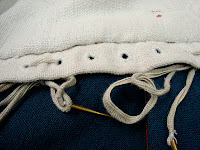In the 17th century a girdlestead was basically the line of the waist of a doublet, but could also refer to the inside of the doublet where a line of metal eyes would be sewn in, especially if it was part of a suit of clothes with a pair of breeches. For many years, the accepted way to wear a suit, especially in the Elizabethan era and early 17th century was to lace together the two with ribbon or cord points. These passed through thread worked eyelets that lined up together between the waistband of the breeches and the doublet. This is what's going on with Charles's suit here when he was painted by Muytens in 1631.
 In the times before it was acceptable to use a belt for keeping your breeches up or braces being invented, this was the way to stop them falling down. Is the 1640s however this had developed into metal eyes sewn to the doublet and matching hooks on the outside of the waistband of the breeches. John Belasyse painted by Gilbert Jackson in 1636 has no obvious external ties joining his doublet and breeches.
In the times before it was acceptable to use a belt for keeping your breeches up or braces being invented, this was the way to stop them falling down. Is the 1640s however this had developed into metal eyes sewn to the doublet and matching hooks on the outside of the waistband of the breeches. John Belasyse painted by Gilbert Jackson in 1636 has no obvious external ties joining his doublet and breeches. Several of the surviving doublets in museums have eyes sewn to the inside of the waistband. The Boy's Doublet in Abingdon for instance has two metal loops remaining in the waistband and the dark Isham one in the Museum of London (pictured) has eyes all around the waist. It's obvious from this that all classes, from ordinary boys to lords wore suits connected together with hooks and eyes.
In a pamphlet from 1652 entitled "A Letter To Mr Marriott", the famous London lawyer is lampooned for his gluttony and apparently other salacious practices from the front page picture. What you can see however from the breeches around his ankles that if he had wished to keep them up, he would have hooked them into his doublet.
I'm not sure however how far this practice was carried out during the Civil War for those serving in the armies. There is no mention in any records of hooks and eyes being purchased for soldier's suits, whereas things like buttons are listed frequently. It would also be tricky if you had your own breeches to get an issued coat with eyes that matched the hooks. who knows, as there is no evidence either way we can't tell. However as I have related, it was something that a lot of men were used to, so maybe they went out of their way to customize their clothes. It would make a kind of sense.





I think as in most things, there are those that would & those that would find a more practicle way.
ReplyDeleteRegards.
http://woodsrunnersdiary.blogspot.com/
Sorry for posting on such an old thread but...
ReplyDeleteThe question of soldiers, breaches and attaching them to coats...Do we have any record of attachments being on coats rather then doublets? If there are not, and the breeches are just fitted well...I would think they would need to be re-fitted often if the wearer shrank due to lack of food...um...anyway, just rambling.
Hi Mr King. I've found out quite lot since I wrote this post, though I'm still to find any evidence for eyes on coats. I have however seen a few references to soldier's breeches having hooks attached, particularly the NMA issue in 1645 which would imply that something on the top half was presumed to have eyes for the hooks to attach to. There are also documentary references to doublets being issued to soldiers as well as coats, some of which detail eyes to be attached. It seems logical that a layered approach was a common method, with a doublet under the coat in many cases, even if it was just to keep the breeches up. I know breeches can be self-suspending but my theory is that was what they were used from laced doublet and hose, so they weren't in any hurry to change.
ReplyDelete